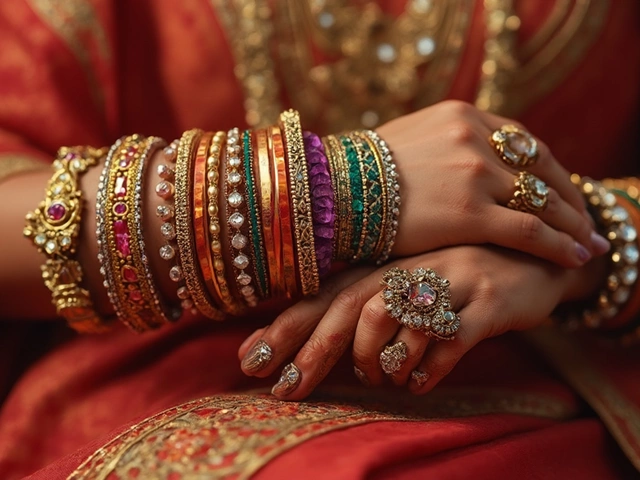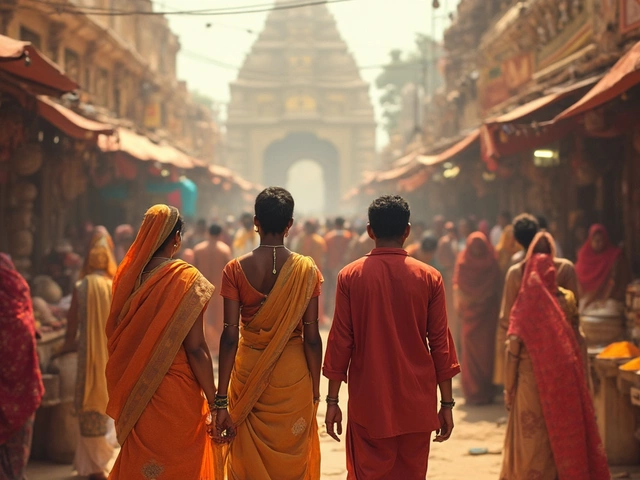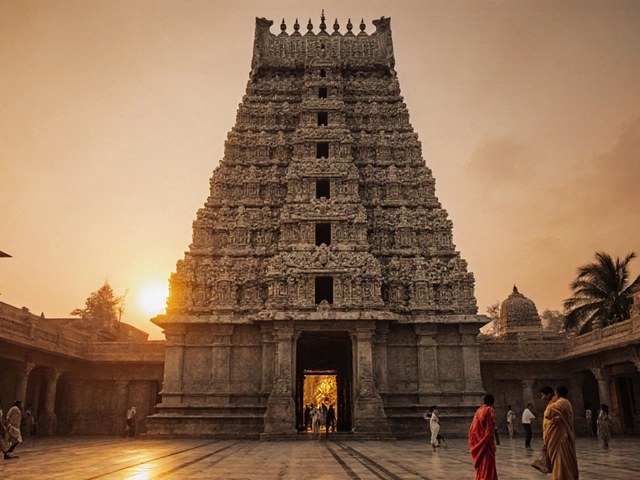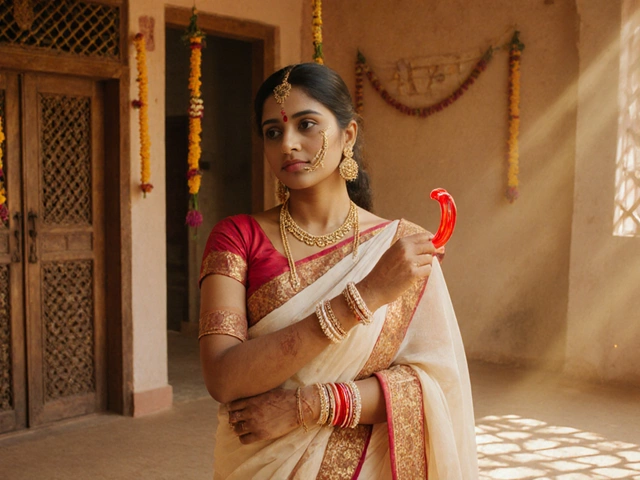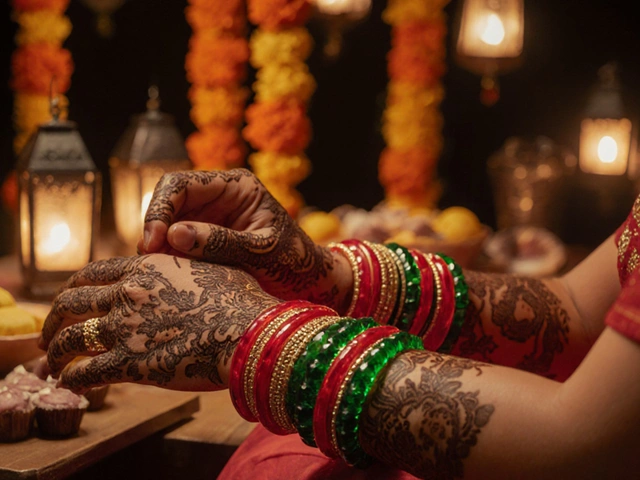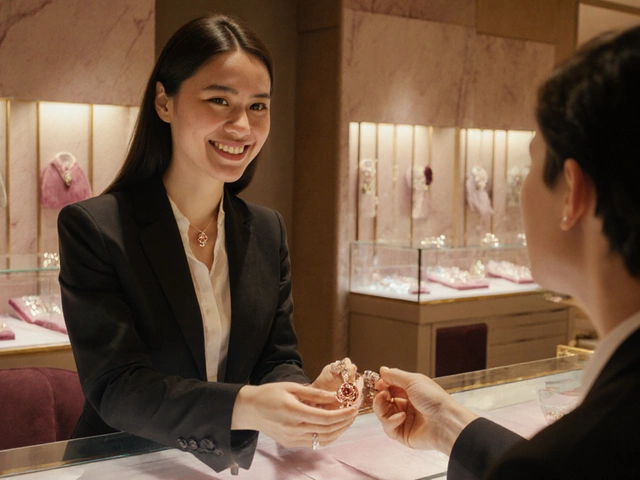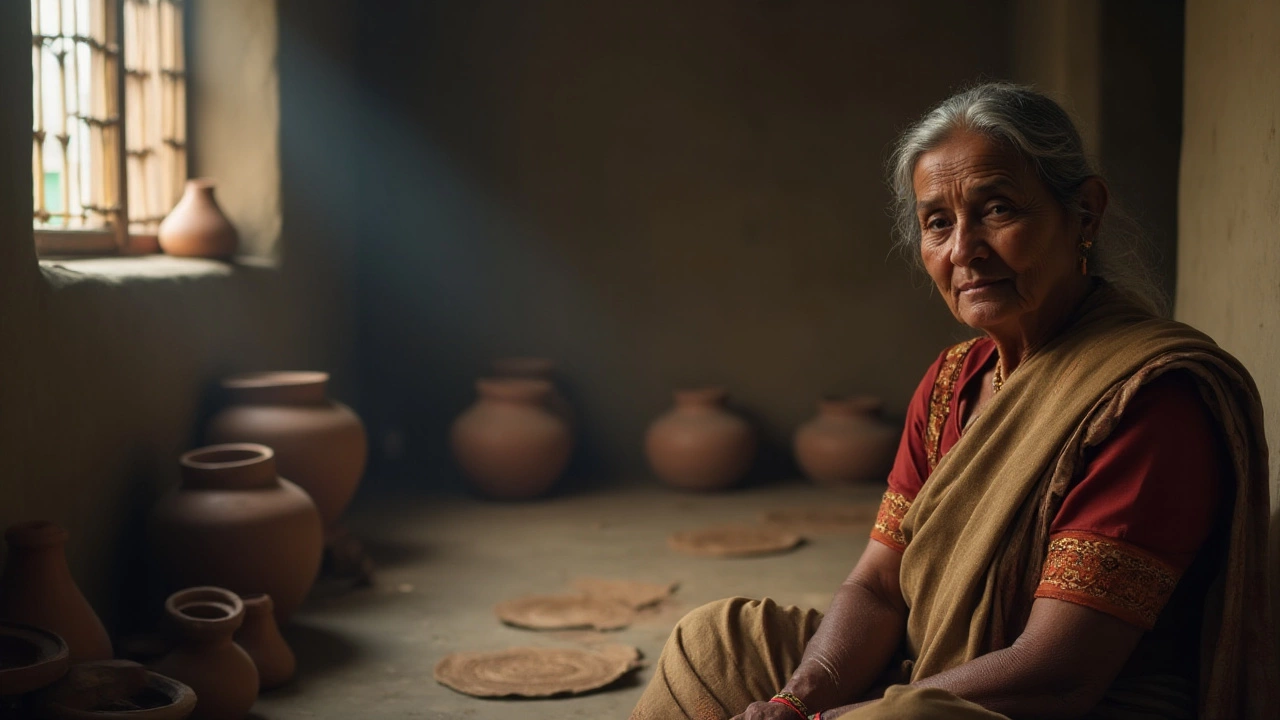
In the vibrant tapestry of Indian culture, the bindi serves as more than just a decorative mark on a woman's forehead. It is a symbol of marital status, a form of personal expression, and a cultural marker that speaks volumes without uttering a word. Yet, the absence of this small yet significant dot on a widow's forehead echoes with profound cultural meanings.
For centuries, the transition from a life of togetherness to the solitude of widowhood has been marked by certain visible changes, including the removal of the bindi. This ancient tradition has roots that run deep into India's religious and cultural soil, reflecting the change from a married state to widowhood.
While bindi and mangalsutra both play key roles in denoting a woman's marital bliss, the designs of mangalsutra have also undergone significant transformation over the years, blending artistic elegance with cultural significance. These adornments, rich in symbolism, extend beyond their aesthetic appeal and into the realm of identity and heritage.
As society evolves, so do the practices associated with these traditional symbols. Today, many women choose to reinterpret these symbols in ways that resonate with their personal beliefs and the contemporary world they inhabit. This exploration serves as a guide for understanding how these age-old customs have transformed and continue to shape the cultural landscape.
- Historical Roots of Bindi
- Widowhood and Its Symbolic Changes
- Intricate Designs of Mangalsutra
- Modern Interpretations and Changes
Historical Roots of Bindi
The bindi is not merely a decorative accessory in Indian tradition; it is a representation of cultural heritage that resonates across centuries. Traditionally applied at the location of the sixth chakra, the 'ajna,' or the third eye center, the bindi plays a significant role in spiritual and social representations. Its journey through history is as colorful as the vibrant hues that decorate the foreheads of millions of women across the globe. The practice dates back to prehistoric times when mankind first started using colored earth as body decoration. According to Vedic texts, the spot between the eyebrows is considered the seat of concealed wisdom, symbolizing a point of spiritual augmentation and the storage of energy, thus reinforcing its profound relevance.
The bindi's spiritual and metaphysical foundations gave rise to a plethora of beliefs surrounding it. In the context of marriage, the bindi serves as a symbol of both love and prosperity, often perceived as a protective measure that ensures the safety of the husband, thus consolidating its importance as an indicator of a woman's marital status. Across the different regions of India, the bindi possesses varied interpretations and purposes; for instance, in the South, it is considered a symbol of female energy and empowerment. A study highlighted that nearly 80% of Indian women wear bindis as part of daily routine, which underscores its commonplace acceptance and enduring appeal.
The cultural narrative of the bindi is further enriched through its artistic representation. Traditionally, it is made of red vermilion powder or sindoor, a red coloring agent that marks the auspiciousness of marriage. However, in recent times, bindis have evolved into stylish accessories made from various materials, including felt with adhesive at the back, to accommodate modern applications while keeping up with cultural traditions. Renowned anthropologist Sudhir Kakar once said, "The bindi is more than an ornament; it is an emblem of a woman's desire for the harmonious integration of beauty with an inner, spiritual calm."
The bindi, much like the hieroglyphs of ancient Egypt, narrates the socio-cultural evolution of a civilization through its artistic expressions."
The social connotations of widows not wearing the bindi find roots in these ancient customs. Upon the demise of a husband, the removal of the bindi denotes a shift from one phase of life to another, reflecting the profound value attributed to marriage in Indian society. This customary practice, though widely observed, is not rigid across the country, as many contemporary communities witness a shift towards personal choice and autonomy regarding these age-old traditions. Such shifts are indicative of the evolving landscape of cultural practices, where personal beliefs often take precedence over communal norms, leading to more nuanced interpretations of what it means to uphold tradition in the modern era.
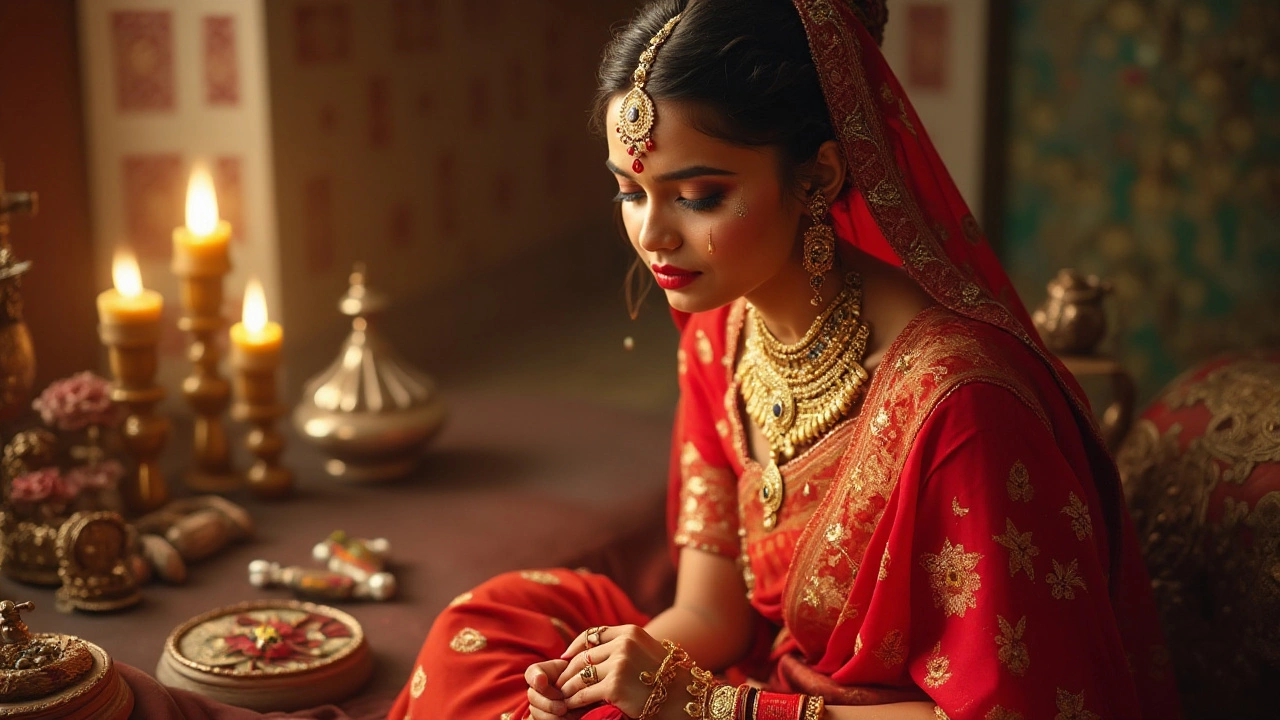
Widowhood and Its Symbolic Changes
In traditional Indian society, the transition to widowhood is accompanied by a series of visible and symbolic changes. Though time has seen some alteration in practices, these changes are deeply rooted in cultural lore and the collective psyche. The most conspicuous of these is the removal of the bindi from the forehead. This act signifies the end of a woman's married life and her entry into widowhood, a phase marked by various cultural expectations and norms. The bindi, which many view as an emblem of marital bliss, becomes conspicuous in its absence. The symbolic donning or removal of adornments such as bangles, sindoor, and the mangalsutra, plays into this transition, communicating her changing social status. In some communities, the widow’s attire also sheds the colors of celebration, adopting more muted tones as a reflection of her altered life status.
Historically, such rituals speak to the larger themes of mourning within the cultural narrative. However, these symbolic changes also offer a glimpse into societal structures where women's lives are often defined by marriage and familial roles. Widowhood, in many ways, spotlights the nuances of gender roles and the weight of cultural expectations. As stated by renowned sociologist Dr. Anjali Kamat in her discourse on cultural practices,
“These rituals, ancient and profound, cast light on the intricate weave of tradition where a woman's identity is tightly knit with her marital status.”The symbolic changes, although seen as a means to denote a woman's new phase of life, often highlight a grim departure from social interactions she once enjoyed.
Beyond the symbolic, these changes entail practical ramifications within the societal framework. The widow’s presence at certain festivals or auspicious occasions, for instance, may be restricted due to age-old superstitions, notwithstanding the modern push towards inclusive social norms. This exclusion underscores a prevailing notion, albeit waning, of negativity associated with widowhood. From a social standpoint, these customs give way to discussions about the evolving role of women in Indian households and beyond, and how these changes are perceived and adapted over time. As conversations around such practices surface, many families and communities are re-evaluating the age-old customs that govern widowhood, with some choosing a path of inclusivity over exclusion.
To better understand the cultural dynamics at play, one could look at regions where these customs are still widely practiced and regions where modernity has taken precedence. This duality provides insight into how cultural traditions either persist or transform under the currents of change and modernity. While some adhere steadfastly to these customs, others are embracing new interpretations as women’s roles within households continue to evolve and adapt to contemporary society. The ongoing shift in perspective is a reflection of broader social changes that integrate respect for tradition with the quest for gender equality.
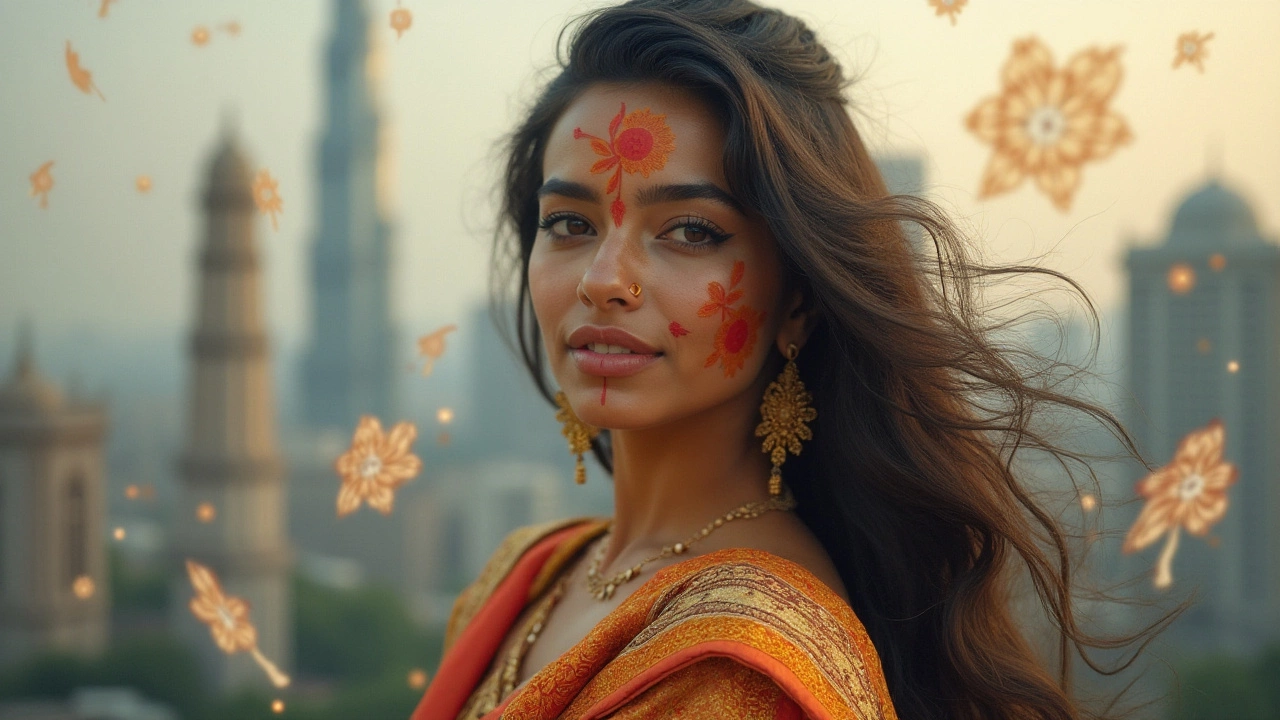
Intricate Designs of Mangalsutra
The mangalsutra, often referred to as the sacred thread of love, resonates with rich cultural and emotional significance in Indian marriages. This ornament is not merely a piece of jewelry but an emblematic representation of the marital bond. Traditionally made of black beads interspersed with gold, the mangalsutra design has evolved immensely over the years, adapting to contemporary styles while retaining its ancient charm. Each component of the mangalsutra bears a special meaning. The black beads, for instance, are believed to ward off evil energies, safeguarding both the marriage and the married life that follows. As such, the design often varies in complexity, from the simplest threads to those adorned with intricate gold filigree and studded with precious stones, reflecting both personal taste and regional variations.
Today, the market is brimming with numerous types of mangalsutra designs catering to different preferences and cultural nuances. Some feature minimalist designs with a single, elegant pendant, while others present a more lavish array of patterns, reminiscent of Hindu mythology and religious motifs. In southern India, it is not uncommon to find mangalsutras depicting the divine images of deities like Lord Krishna or Lakshmi, believed to bless the wearer with prosperity and a happy married life. Modern jewellers have embraced a fusion of traditional artistry with modern elegance, crafting mangalsutras that can be worn daily without compromising on style. These innovations make the mangalsutra not only a symbol of marital dedication but also a fashion statement.
"The beauty of the mangalsutra lies in its versatility and the stories it carries of countless generations," notes renowned jewelry designer Neelam Kothari. "It's not just about the aesthetics; it's about connecting with heritage while adding a personal touch."
With the increasing influence of global fashion, many brides today opt for customized designs that reflect their personal style. Designers are experimenting with various elements, incorporating diamonds, gemstones, and even platinum into the traditional gold and black bead framework. This customization trend allows brides to have a unique piece that stands out, adding a personal significance that aligns with their modern sensibilities. Even Bollywood has contributed to this trend; celebrities often showcase exclusive mangalsutras that blend traditional motifs with avant-garde design, setting trends for millions of fans across the globe. These variations cater to the burgeoning demand for styles that complement contemporary wardrobes while still holding their sacred meaning.
Interestingly, the diversity in mangalsutra designs has also birthed a genre of catalog jewelry that is primarily fashion-driven, allowing for the incorporation of motifs from other cultures and regions. In regions like Maharashtra and Gujarat, the traditional peacock design is popular, symbolizing grace, beauty, and a creative brilliance that mirrors the spirit of Indian weddings. Meanwhile, in the north, pendants often sport the motif of the lotus flower, a symbol of purity and enlightenment. This regional diversification speaks to the rich tapestry of Indian ethos and how these pieces of jewelry become interfaces of personal and cultural expression. An increasing number of young brides are choosing styles that seamlessly transition across both traditional and contemporary settings, recognizing the versatility and timelessness of these designs.

Modern Interpretations and Changes
In recent years, the traditional practices surrounding the use of the bindi and the removal of it by widows have seen a wave of transformation. As the world becomes increasingly interconnected, cultural boundaries have begun to blur, and people are re-evaluating age-old customs. Many modern Indian women, both in India and the vast diaspora, have started to question and redefine these symbols in ways that align with their personal beliefs and global perspectives. This has led to a notable shift in how these cultural markers, such as the mangalsutra, are perceived and utilized in contemporary society.
One remarkable change is the choice of some widows to continue wearing the bindi as a personal and cultural statement. In a rapidly changing society, many women feel empowered to challenge traditional norms, embracing the bindi not just as a symbol of marital status but as an expression of identity and self-expression. "The bindi can be a symbol of strength and independence," suggests Dr. Anjali Ram, a cultural anthropologist.
"For some, it's a choice to honor their past while embracing their future, a way to merge legacy with modern aspirations."
Similarly, the designs of the mangalsutra have also evolved to reflect a new era of cultural synthesis. No longer confined to elaborate traditional patterns, these jewelry pieces are now crafted in more minimalistic and modern designs that incorporate elements of both East and West. This change caters to young couples who seek something that resonates with modern aesthetics while still maintaining a connection to their cultural heritage. Jewelers have noted a significant increase in demand for such contemporary designs, suggesting a shift towards personalized and meaningful symbolism rather than sticking strictly to conventional styles.
Moreover, the global influence is vividly perceptible in how other cultures have embraced similar practices. The idea of a symbolic accessory that denotes a significant personal milestone resonates across different traditions worldwide. In countries with a large Indian diaspora, there is a blending of traditions, where the mangalsutra is sometimes worn in conjunction with wedding bands, representing a syncretism of cultural identity and modern romantic customs.
This metamorphosis is further fueled by the rising voices of feminist movements across India, championing the rights of women to choose their expressions and identities. Women's advocacy groups have played a crucial role in highlighting these changes, broadcasting the idea that adherence to traditional symbols should be a matter of choice and not of societal imposition. This shift has encouraged many young women to engage in open dialogue about their wishes and preferences, contributing to a broad acceptance of diverse expressions regarding marital symbols.
In light of these modern reinterpretations, many educational platforms and media outlets have also taken up the task of discussing and debating the role of such symbols in everyday life. Documentaries, articles, and television shows continue to explore these themes, engaging audiences in a conversation that balances respect for tradition with a desire for personal autonomy and cultural evolution. This ongoing dialogue ensures that these age-old practices continue to resonate, albeit in new and inventive ways, with upcoming generations.


